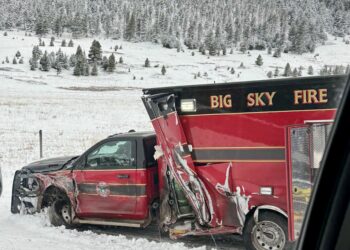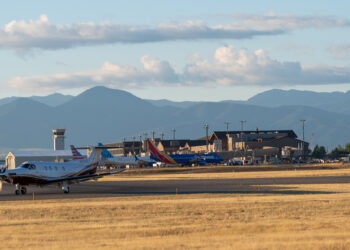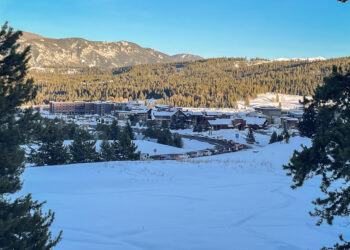By Joseph T. O’Connor
Mountain Outlaw Editor-in-Chief
Brian Schweitzer points to a fur hide lying next to a Native American headdress on his office table.
“You ever held a skunk pelt before?” he asks.
It’s October 2012, three months before the term-limited Montana governor will leave office.
Holding the pelt in a calloused hand, he talks about special interest groups and how they’ve learned to
steer clear of the Capitol building in Helena. Schweitzer says he removed all lobbyists from his commissions and boards once he took office in 2004.
“I keep this skunk pelt in here so I don’t forget what they look and smell like.”
During the 2012 election season, Montana was a focal point for the nation as voters sifted through
political messages, numbed by tens of thousands of negative campaign ads. Millions in outside cash
poured into the state, spinning the heads of anyone following the news.
While Schweitzer kept a close eye on the issues this fall, the race wasn’t his to win. After eight years in the public eye, Montana term limits say he must go, but the governor won’t be cleaning everything out of his office. He’s leaving tracks.

Schweitzer, 57, has amassed an unprecedented budget surplus, and signed bills for early education,
renewable energy, tourism and jobs. He’s exercised his power to veto 130 times, taking down laws that
would have shortchanged public schools and eliminated same-day voter registration. He is leaving office with a 61 percent approval rating.
That’s the governor on paper. In person, he’s larger than life. He’s 6’2”. He wears big boots and big belt buckles. He owns big ranches with big tractors. He dreams big.
But Schweitzer is accessible. He tells stories that ground him in Montana, connecting him to its people and to a house on a dirt road, where he sees himself after his last day in office on Jan. 7 – at least
temporarily.
The rest of the country got its first taste of Governor Schweitzer at the 2008 Democratic National Convention, where he delivered a speech that catapulted him into the national spotlight.
Adorned in his trademark bolo tie, Schweitzer told the convention his family story – how his grandparents immigrated to Montana “with nothing more than the shirts on their backs, high hopes and faith in God.”
He spoke of how his parents had two things in their house he’ll never forget. The first was a crucifix. The second was a framed picture of John F. Kennedy on their kitchen wall.
Schweitzer’s parents never graduated high school, but “President Kennedy’s idealism and spirit of the
possibility inspired them to send all six of their children to college.”
And when he said ‘We’re going to the moon,’” Schweitzer said, pointing skyward at the convention,
“he showed us that no challenge was insurmountable.”
The governor opened his address sounding like the down home rancher he is, an amiable neighbor you
might invite to Sunday dinner. He closed by bringing the convention to its feet, calling for national energy independence and a collective belief that together we can change the world. He closed as a leader.
__________
Montana is traditionally a red state. Until 2004, it hadn’t elected a Democratic governor in two
decades. The Treasure State has voted for just two Democratic presidential candidates since 1952.
So, how did a Democrat get elected here the same year the state voted overwhelmingly to re-elect Republican President George W. Bush?
Schweitzer tells a story about Bill Clinton’s path to politics, illustrating a difference between the two politicians. When the former president was 13, he knew networking would lead him to Washington.
“He used to go to conferences and get every single person’s mailing address, and he’d send them a nice note,” Schweitzer said. “He’d check in with them a couple times a year because he knew what he wanted to do.”

Schweitzer didn’t do this; he never expected to be governor. His path led to Libya the day after he defended his thesis in soil science at Montana State University in Bozeman. From there, he spent seven years in Saudi Arabia working on irrigation projects intended to boost the area’s agriculture. He’s now fluent in Arabic.
“The people I was meeting were either Arabs or Europeans or Africans,” Schweitzer said. “And I don’t think any of them can vote for me here in Montana.”
In 1986, he returned to Montana to raise cattle at his Whitefish ranch. “I never thought too much about politics,” said the husband and father of three. “I voted and read the newspaper like a lot of folks do, and once in a while I’d flip on the Sunday morning television programs to see what the heck was happening back there in Washington, D.C. But if somebody would have suggested, ‘You’re someday gonna run for governor,’ I would have said, ‘Governor of what?’”
Over the years, Schweitzer noticed trends and changes in the business climate, in education and in the greater community of Montana. He began asking questions. “You find out the people running this [government] stuff – they either aren’t very informed or they’re not very smart.” For a while, though, he said, he “was a complainer like everybody else.”
Then someone asked him, if he was so smart, why didn’t he run for governor.
“It sounded kind of crazy to me,” Schweitzer said. But he realized holding public office was something he had to do. “I thought, if regular people with a common sense background don’t step up, the same cast of characters will continue to run the state into the ground.”
__________
Two photographs stand out in the lobby of Schweitzer’s Helena office.
In one, Schweitzer, in his usual jeans, boots and bolo tie, kneels next to his border collie, Jet. The other is Lieutenant Governor John Bohlinger sporting a bow tie, the American flag in the background.
These photos might have been opposite each other on a campaign ad, but here they’re mounted side-by-side. Schweitzer chose Bohlinger, a Republican, as his right-hand man in 2004. The partnership has worked, Schweitzer says, because both men were willing to challenge their bases in order to meet in the middle. Politics isn’t a popularity contest, Schweitzer says.

“You’ve got to articulate what yer fer, and what yer against,”
he said, in an exaggerated Montana accent. “And what yer fer
– ya gotta be willin’ to fight for it.”
He’ll reach across the aisle, but Schweitzer is no pushover. Three photos hanging near his office door show former president Lyndon B. Johnson talking with a congressman.
Schweitzer narrates: “Here, LBJ is saying, ‘This is a good idea. I think we can both agree on this. The senator is saying, ‘Well, I’m not so sure.’”
In the second photo, Johnson is face-to-face with the congressman, leaning in, angry. In the third, Johnson has a finger in the chest of the cowering congressman, who is bent
backward over a desk. Schweitzer jabs a finger at the photo. “LBJ is saying, ‘I’m not going to take no for an answer.’”
“That’s what you do,” Schweitzer says. “You first romance them, tell them how beautiful their wife is. You ask them if they’ve been working out. But at some point, you tell them, ‘Look here, you little son of a bitch, this is the way it’s gonna be.’ That’s how you get things done.”
The governor pulls his four-foot “VETO ” branding iron from behind his desk. “You ever hold a hot iron brand before?” he asks.

On April 13, 2011, Schweitzer famously stood on the steps of the Capitol building and vetoed 17 bills with this iron, the paper catching fire with each brand. He called the bills “frivolous, unconstitutional, and just bad ideas,” and seven of them are now displayed on wooden planks in the statehouse lobby, their numbers and the word “VETO ” seared into the wood.
In total, Schweitzer vetoed 79 bills in 2011 – 60 more than any previous Montana governor had in a year. He’s never had one overridden by the state Congress. One veto had major significance for Montana travel destinations. House Bill 316, according to Schweitzer, would have cut state tourism funds and promotions by $6 million.
“I vetoed that because tourism is such a big part of Montana’s industry,” he said, noting that the industry supports 25,000 small businesses in the state. And Montana, he says, is like a business itself: You have to promote the product.
In April 2012, Schweitzer drove a semi truck through Times Square, New York City. He leaned out the window, speaking into a bullhorn, “like a political P.T. Barnum,” wrote The Denver Post.
Schweitzer’s 18-wheeler was wrapped in a giant vinyl banner reading, “Montana: Gateway to Yellowstone.” Bozeman had a new direct flight from Newark, New Jersey, and the governor wanted to promote it. “Who better?” he said. “Nobody loves this state more than I do.”
Schweitzer will leave behind an estimated surplus of $457 million for the state. Alongside what he called “the greatest investments in new education and the greatest tax cuts in history,” it’s something he’s proud of. As part of his final budget submission to the 2013 legislature, the governor proposed using part of the surplus to freeze college tuition costs, his third such proposal.
Schweitzer said his most important investment in education was for full-time, state-funded kindergarten.
“Let’s say you [live with] your grandmother on an Indian reservation, and English isn’t her first language. What are the chances you’ll start first grade on an even keel with the rest of the first graders?”
Early education, he says, is key to a child’s progression through higher education and ultimately to landing a good job. He maintains that if children don’t read at a first grade level by the end of first grade, they never catch up.
“In 25 years, we won’t remember who was governor when these kids are changing the world, as 30-year-old adults with college degrees. We won’t know and we won’t care.”
But Brian Schweitzer will know.
__________
Upon leaving office, Schweitzer’s dream is to return to his roots and the tranquil life on his ranch. He has always lived at the end of a dirt road, except in college and during his eight years as governor. But he gets a gleam in his eye when discussing future political office.
The last year has seen Schweitzer bounce from talk shows with Letterman and Bill Maher, to NYC and
this year’s DNC. He’s basking in the media attention. His conversations with delegates from New Hampshire
and Iowa in September 2012 drew national interest, because they help decide who receives presidential nominations.
“Maybe I spoke to South Carolina, too,” Schweitzer said, grinning. “I might have even talked to Nevada. But I don’t know why that’s a collection of states one would care about.”
Then he laughed.
“I’m not gonna rule anything in, or anything out,” he said. “But I’m not looking to be elected [to national office] just to be elected. I would do it, but only if I thought we could change the world together.”













